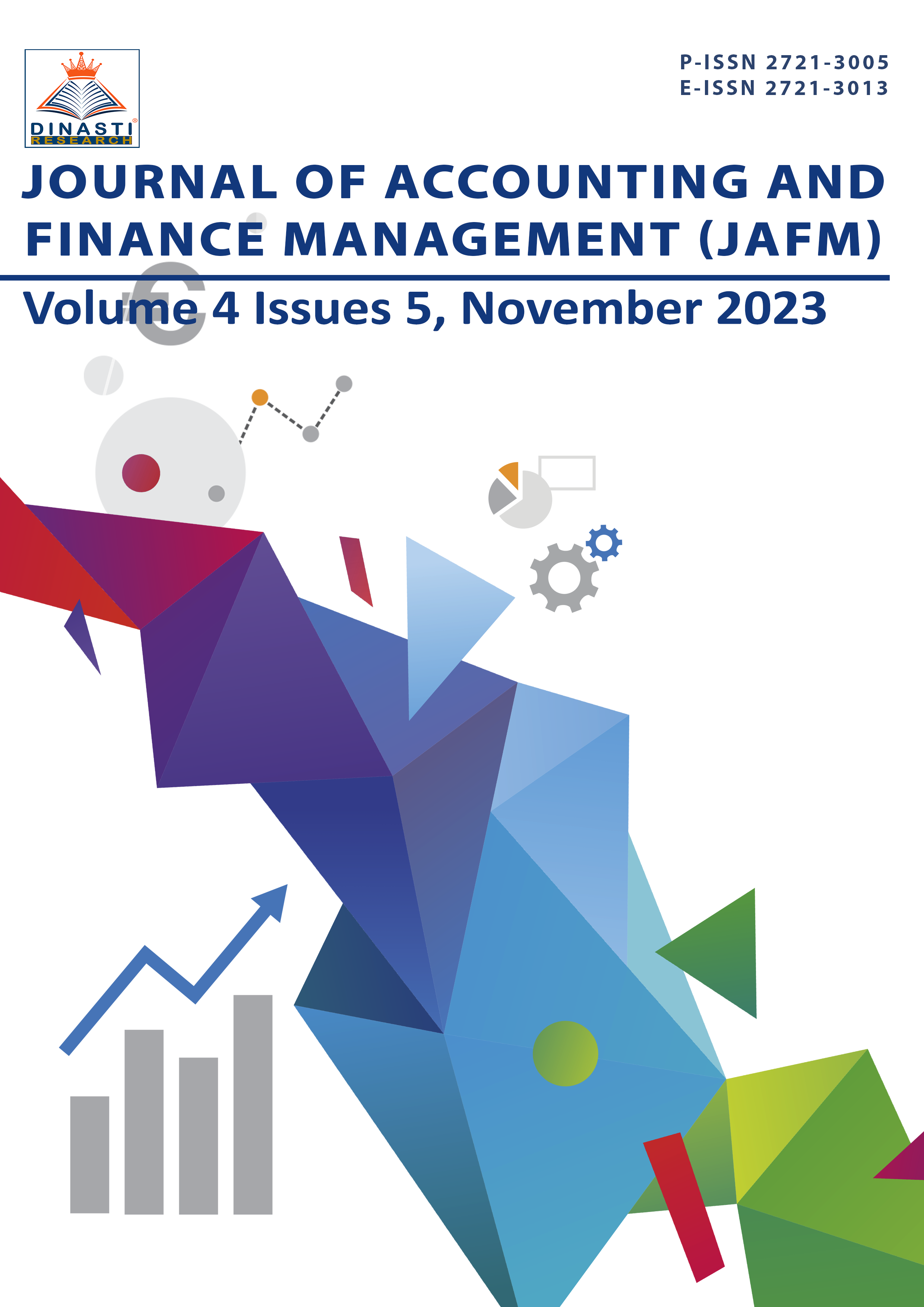The Effect of Comparative Employee Compensation on Wage and Salary Payments
DOI:
https://doi.org/10.38035/jafm.v4i5.268Keywords:
Compare Compensation; Employee Compensation; Salary; WageAbstract
This research aims to determine the effect of compensation comparisons on non-financial sector companies in Indonesia listed on IDX. The population of this research is all non-financial sector companies consisting of the raw materials, manufacturing and services sectors registered on IDX for the 2019-2021 period. This study uses a quantitative approach. The data analysis technique uses panel data regression. The research results show that salary comparison has a positiive and insignificant effect on company performance. The contribution of this research is to provide information about several factors that influence employee salaries. Also in a different population compared to before, you can find out the incentives given to company employees.
References
Bandono, A., Nugroho, S. H., Suharyo, O. S., & Susilo, A. K. (2022). The Influence of Salary, Work Facilities, and Leadership Factors on Employee Performance. Journal of Theoretical and Applied Information Technology, 100(21).
Bloom, M. (1999). The performance effects of pay dispersion on individuals and organizations. Academy of Management Journal, 42, 25–40.
Bryson, A., Buraimo, B., & Simmons, R. (2011). Do salaries improve worker performance? Labour Economics, 18(4), 424–433.
Chen, D. H., Fan, C., & J, S. Y. (2015). Executives and employees: comparison and interaction of incentive effectiveness. Management World. Management World, 5, 160–171.
Downes, P. E., & Choi, D. (2014). Employee reactions to pay dispersion: A typology of existing research. Human Resource Management Review, 24(1), 53–66.
Fauth, R., Bevan, S., & Mills, P. (2008). Employee performance in the knowledge economy: Capturing the keys to success. Psychol Res Behav Manag, 2009(2), 1–12. https://doi.org/https://doi.org/10.2147/PRBM.S4216
Heneman, R. L., Greenberger, D. B., & Strasser, S. (1988). The relationship between pay?for?performance perceptions and pay satisfaction. Personnel Psychology, 41(4), 745–759.
Kepes, S., Delery, J., & Gupta, N. (2009). Contingencies in the effects of pay range on organizational effectiveness. Personnel Psychology, 62, 497–531.
Kwak, J. (2009). An Empirical Study of “Fringe Benefits” and Performance of the Korean Firms. International Journal of Business and Management, 4(2), 3–7.
L, S., & Chang, J. (2011). The influence of manager-employee salary gap on the performance: By the data from Chinese listed companies. 2011 IEEE 3rd International Conference on Communication Software and Networks, Xi’an, 540–543. https://doi.org/10.1109/ICCSN.2011.6013890
Lestari, V. N. S., & Cahyono, D. (2017). Sistem Pengupahan di Indonesia. Journal of Economic and Islamic Law, 8(2), 144–153.
Li, T., F., M., Fu, L., & Jin, X. (2019). Relative income and subjective economic status: The collectivist perspective. Econ. Res. J, 12, 118–133.
Lu, C., & Niu, Y. (2022). Do companies compare employees’ salaries? Evidence from stated-owned enterprise group. China Journal of Accounting Research, 15(3).
Muralidharan, K., & Sundararaman, V. (2009). Teacher performance pay: Experimental evidence from India. National Bureau of Economic Research, 1(1), 1–48.
Pinto, E. P. (2011). The Influence Of Wage On Motivation And Satisfaction. International Business & Economics Research Journal (IBER), 10(9), 81–92. https://doi.org/https://doi.org/10.19030/iber.v10i9.5629
Shen, Y., Fan, C., Chen, D., & Liu, J. (2017). Explicit contracts, employee rights protection and the rise in the labor cost: Exploring the role of the labor contract law. China Journal of Accounting Researchhina Ind. Econ, 2, 117–135.
Shen, Y., S., Y., & Juang, D. (2019). Can the improvement of air quality reduce the labor cost of enterprises? Manage. World, 6, 161–178.
Simanjuntak, P. J. (2000). Pengantar Ekonomi Sumber Daya Manusi – Edisi Kedua (4th ed.). Lembaga Penerbit- FE UI.
Trevor, C. O., & Wazeter, D. L. (2006). A contingent view of reactions to objective pay conditions: Interdependence among pay structure characteristics and pay relative to internal and external referents. Journal of Applied Psychology, 91, 1260–1275.
Vosloban, R. I. (2012). The Influence of the Employee’s Performance on the Company’s Growth - A Managerial Perspective. Procedia Economics and Finance, 3(12), 660–665.
Widodo, D. S., & Yandi, A. (2022). Model Kinerja Karyawan: Kompetensi, Kompensasi dan Motivasi,(Literature Review MSDM). Jurnal Ilmu Multidisplin, 1(1), 1–14.
Xia, N., & Dong, Y. (2014). Executive compensation, employee compensation and corporate growth: Based on listed SMEs in China empirical data. Accounts. Res, 9, 89–95.
Zhou, J., & Liu, B. (2012). Regional labor mobility, asset specificity and employee salary: An empirical analysis based on industry and provincial panel data of China. Nankai Econ. Studs, 5, 79–93
Downloads
Published
How to Cite
Issue
Section
License
Copyright (c) 2023 Caterina Aruli Iskandar Catrin, Driana Leniwati, Agung Prasetyo Nugroho Wicaksono

This work is licensed under a Creative Commons Attribution 4.0 International License.
Authors who publish their manuscripts in this journal agree to the following conditions:
- The copyright on each article belongs to the author(s).
- The author acknowledges that the Journal of Accounting and Finance Management (JAFM) has the right to be the first to publish with a Creative Commons Attribution 4.0 International license (Attribution 4.0 International (CC BY 4.0).
- Authors can submit articles separately, arrange for the non-exclusive distribution of manuscripts that have been published in this journal into other versions (e.g., sent to the author's institutional repository, publication into books, etc.), by acknowledging that the manuscript has been published for the first time in the Journal of Accounting and Finance Management (JAFM).




























